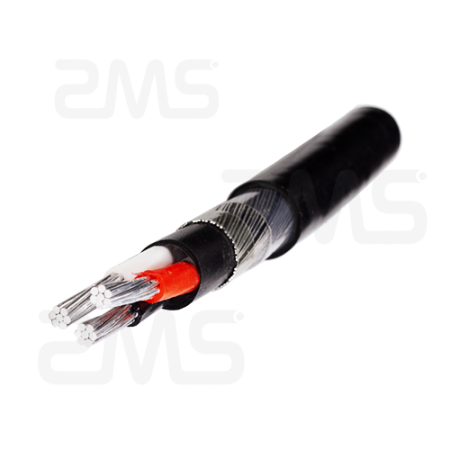
Concentric cable is a type of stranded conductor that has a central wire or core surrounded by one or more layers of helically laid wires in a geometric pattern.
It is used by UK Distribution Network Operators (DNOs) such as Scottish Power Energy Networks (SPEN), Scottish & Southern Energy (SSE) and UK Power Network (UKPN) to provide the final connection to residential properties. It is also suitable for sub main distribution boxes, Street lighting systems and high rise buildings.
Conductors
The conductors in a concentric cable are generally made of copper or aluminium. These metals are ductile and resistant to corrosion. They are also relatively cheap, so they can be used for a wide range of applications.
They are available in a number of sizes to suit the particular circuits in which they are used. They are also typically manufactured with a layer of insulation covering them.
These layers help to protect the conductor from mechanical damage and also reduce the amount of energy that can be transferred through them. They also aid in preventing arcing from occurring and the formation of sparks.
Another advantage of these types of cables is that they are comparatively thin walled, making them ideal for use in high voltage circuits. This helps to save space and reduces the overall weight of the cable.
Concentric conductors are formed by laying wire strands in a symmetrical pattern around a central wire (strand). The strands may be placed in different directions or in the same direction, depending on the application.
According to IPCEA Standard BS EN 6004-4, concentric conductors can be made with 7, 19, 37, or 61 strands or members. Normally, these strands are laid in the same direction for all layers.
In some cases, a core is laid in between the strands to improve the strength and durability of the conductor. This is especially common in twisted copper conductors, and it provides some advantages over other constructions for the same application.
They are mainly used by Distribution Network Operators to link electricity networks and towers to people’s homes and businesses. They are also useful for sub-mains in high rise towers and street lighting systems.
Aside from these, they are also used in various other electrical equipment and systems. These conductors are also able to withstand large amounts of stress, and their conductive qualities make them highly suitable for carrying power in industrial environments.
These conductors are also used in electric power supplies with protective multiple grounding systems. These systems connect the combined neutral and ground conductors to the actual earth in several places to reduce the risk of an electric shock if a pen breaks.
Insulation
Insulation is a layer of material that separates the conductor from the concentric neutral wires in power cables rated above 1 kV. The insulating material is usually cross-linked polyethylene, but it may also be ethylene propylene rubber (EPR). The thickness of the insulation varies with the cable size and voltage rating.
Concentric cable typically has a main conductor consisting of a single solid wire or of stranded wires of copper or hard drawn aluminum. The insulated conductor is surrounded by a semi-conducting shield that provides a smooth void-free interface between the conductor and the concen-tric neutral wires.
The conductor may be helically wrapped with a deformation resistant thermoplastic semi-conducting shield or it may be covered with a coating made of cross-linked thermosetting or thermoplastic polyethylene. The number of concentric neutral wires varies according to the conductor size, the phase system (single phase or three phase) and the voltage rating.
In addition, concentric neutral wires can be protected with a jacket made of semi-conducting material in order to prevent them from oxidation at high currents and to enhance their mechanical and moisture resistance properties. However, such jackets are expensive and require special handling equipment and can be difficult to install.
Therefore, it is an object of the present invention to provide a low cost power cable of the concentric neutral wire construction having improved mechanical and moisture resis-tance properties. The cable comprises a conductor, a layer of insulation material surrounding said conductor and a series of concentric neutral wires applied helically over the layer of insulation material, each concentric neutral wire being covered with a deformation resistant thermoplastic semi-conducting shiel-ing.
It is further characterized by the fact that each concentric neutral wire is coated separately, and in lieu of a common overall jacket used in conventional cables. This permits each concentric neutral wire to be independently coated and thus if one of the wires is damaged, only that wire is affected. In this way, the normal operation of the cable is not hampered.
Concentric cables are commonly used in power distribution, panel, and street lighting areas where increased electrical and mechanical protection is required. They are installed in open air, underground, and in cable ducts. They are generally accompanied by grounding devices to protect them from electric shock. They are also available in split versions for direct burial.
Armor
Depending on the design, armored cables are divided into steel wire armored cable (SWA) and steel tape armored cable (STA). These cables provide mechanical protection and can be used outdoors or in direct burial projects.
The armor is typically a reinforced layer of steel wires or steel tape, which increases the strength and durability of the cable. The armour also improves its magnetic shielding effect and enables it to withstand low-frequency interference.
Armored cables have many applications, including power and control cable and industrial telecommunications cable. They can withstand high pulling loads and provide excellent electrical insulation properties.
Typical armored cable features include an outer sheath made of flame retardant XLP or PVC insulation, conductors cabled with a ground wire or wires and a continuously welded corrugated aluminum armor encased in a protective jacket overall. The armor is designed to withstand temperatures from 90deg C to 70deg C and service voltages up to 600 volts.
In some concentric cable applications, the armor is used as an equipment grounding conductor path. This provides a more direct path for connecting the MC cable to an equipment grounding bus or metallic outlet box.
This is important in case of a conductive object such as a spade or digger being inserted into the cable. If the conductive object shorts out the armored ground, it will disconnect the circuit and hopefully save the person in the field from injury or death.
Some of the more common types of armored cable include steel wire armored cable, steel tape armored cable and aluminium wire armoured cable. The steel wire armored cable can withstand more mechanical force and is more commonly used in power and control cables.
It is important to remember that armored cables do not have the same bending radius as unarmored cables, so they can be more susceptible to damage when flexed. This can reduce flex life, but it is not always an issue for a properly designed and constructed cable.
The process of manufacturing steel wire armored cables is subject to strict quality assessment according to national and international standards. This is especially true for control and low-voltage power cables.
Applications
Concentric cable is used to carry electrical signals across distances, such as in coaxial cables for television transmission and computer networks. It is also used for radio frequency signals in the form of feedlines connecting transmitters and receivers to their antennas.
This type of cable has a low loss and is useful in high-power applications. It can be buried and run along parallel metal surfaces without compromising signal quality because it confines the electromagnetic field to a small space within the wires.
However, it also has certain disadvantages that can make it unsuitable for some applications. For example, it cannot be bent or twisted without changing its characteristic impedance. This can cause reflections of the signal back to the source, which may affect its fidelity and frequency response.
Furthermore, it may be susceptible to a phenomenon known as signal leakage that results in noise and interference on the line. This can be caused by a number of factors, including improperly installed connectors and faults in the shield.
It is important to choose a concentric cable that provides the best combination of performance and cost for your application. It is also a good idea to choose a manufacturer that can provide you with the necessary information about your project.
Concentric cables can be manufactured in a variety of sizes and types. Some manufacturers may even offer custom solutions for your needs. They can also cut the cable to length and store it for you so you can purchase it when you need it.
Another advantage of this type of cable is that it is easy to splice and make connections with. This is because it features reversed helical lays that vary from a half turn up to several complete turns in one direction.
Additionally, it has a lower zero order impedance and higher proper (inverse order) impedance than other kinds of cable. This allows automatic protection devices to detect short circuits more accurately and safely.
In addition, it is also resistant to lightning strike and electromagnetic interference. This makes it ideal for power distribution systems and street light systems coaxial speaker cable
Read More :
- 5 Tips For Optimizing WhatsApp For Better Communication
- How To Use Whatsapp For Business: Tips And Tricks
- Small Businesses: How to Make Money Online
- How to Start a Successful Small Business Without any Investment
- How to Use WhatsApp for organisational communication
- How to Use WhatsApp for More Productivity and Efficiency








